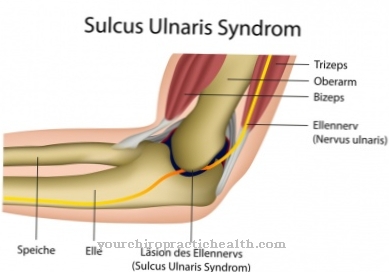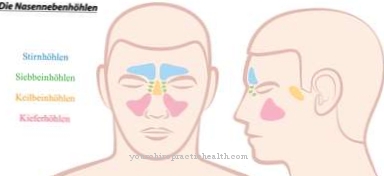It is a rare gynecological disease Asherman syndrome. In the worst case, it can lead to sterility.
What is Asherman Syndrome?

© vladgrin - stock.adobe.com
As Asherman Syndrome, too Fritsch-Asherman syndrome or Fritsch syndrome called, is a gynecological disease in which the uterus is closed by adhesions, usually as a result of surgical interventions. In 1894, the German gynecologist Dr. Heinrich Fritsch first developed intrauterine adhesions and warned of the consequences of intensive scratching when scraping after miscarriages and in the puerperium.
In 1948, the Czech-Israeli gynecologist Joseph G. Asherman described these adhesions as "post-traumatic intrauterine adhesions". The clinical picture was named after him. Four stages are distinguished depending on the extent of the adhesions.
causes
If you look at the anamnesis of affected women, you will almost always find scrapings in the history. Women who are exposed to scraping during pregnancy or when the uterus has not yet regressed after giving birth are particularly at risk.
Schenker and Margalioth presented collective statistics in 1982 in which they documented that 66.7% of the cases of intrauterine adhesions can be attributed to curettages (scrapes) after miscarriages, 21.5% to curettages after childbirth and 2% after a caesarean section.
In 1990 Chapman and Chapman, who were treating women with Asherman syndrome in different countries, discovered a link between adhesions and the use of a sharp rather than a blunt curette. The risk increases with the number of further scrapes.
You can find your medication here
➔ Medicines for menstrual crampsSymptoms, ailments & signs
A common symptom is a lack of menstrual bleeding (amenorrhea) or a short menstrual period (hypomenorrhea). Secondary amenorrhea can occur even after a normal cycle.
If there are adhesions in the uterus and fallopian tubes, a woman may have difficulty getting pregnant. In many cases of infertility, there are adhesions that prevent pregnancy.
Sometimes a pregnancy occurs despite adhesions and the adhesions can lead to the fertilized egg not implanting properly or to miscarriages, premature births or problems in the postpartum phase. The fact that a woman becomes pregnant despite adhesions can be due to the fact that the uterus and / or fallopian tubes are not completely obstructed by adhesions and that there is sufficient intact uterine lining.
The adhesions often cause pain, especially in the case of amenorrhea, when the uterine lining that has built up during the cycle cannot be shed again by the menstrual period due to a uterine blockage.
Diagnosis & course
Diagnosing Asherman syndrome is difficult, especially because the condition is very rare. On the other hand, you don't know how high the number of unreported cases really is in the face of misdiagnosis. A careful medical history is important.
In a typical Asherman syndrome, there have been scrapes in the past and / or surgical interventions on the uterus, for example by a caesarean section. If a woman does not become pregnant and has secondary amenorrhea or hypomenorrhea, evaluation for Asherman syndrome should be made.
After taking a careful medical history, an ultrasound scan may be done, but adhesions are difficult to see on ultrasound. In patients at risk of adhesions, saline hysterosonography (ultrasound examination with a saline solution) can be carried out to see whether there are constrictions or obstructions. In order to examine the uterus more closely, a hysteroscopy (reflection of the uterus) is performed.
Thanks to technical advances, such interventions can already be carried out on an outpatient basis under local anesthesia in 98% of cases. A video hysteroscopy, which another examiner can use to assess the case, reduces the risk of misinterpretations. Hysteroscopy is particularly suitable because, in the case of adhesions, the intervention can be extended to releasing the adhesions at any time.
As part of fertility treatment, hysterol alpinography (X-ray examination of the uterus and fallopian tubes) is often performed, in which the uterus and fallopian tubes are shown with the help of a contrast medium.
Complications
Asherman syndrome has various complications, and in the worst case, complete sterility of the patient can occur. In most cases, Asherman's syndrome leads to the fact that women have no menstrual period at all or only very weak bleeding occurs. As a rule, this is a sign of pregnancy for many women.
However, in many cases, women affected by Asherman syndrome are sterile and the body cannot sustain pregnancy. This leads to strong psychological complaints and depression. Self-esteem is also greatly reduced. In addition to the patient himself, the partner can also be affected by the psychological complaints.
Asherman syndrome causes pain in many cases. If the woman becomes pregnant despite the adhesions, the pregnancy usually ends in a miscarriage. The miscarriage can lead to severe psychological complications that need to be addressed by a psychologist.
The treatment takes place exclusively through an operative intervention. The procedure is very complicated for doctors and does not always lead to success. If the procedure is unsuccessful, adhesions can continue to develop. If successful, the woman may become pregnant. However, pregnancies are fraught with risks.
When should you go to the doctor?
Asherman syndrome does not necessarily need to be clarified by a doctor. A medical diagnosis is recommended if there are persistent symptoms during the menstrual period (missed or delayed periods, etc.). If these symptoms occur after scraping or uterine disease, it is likely Asherman's syndrome.
However, a visit to the gynecologist is not always necessary. However, women who want to have children should have any abnormalities clarified, since untreated Asherman syndrome can lead to infertility, miscarriages and premature births and problems in the postpartum phase.
Depending on the severity of the symptoms, Asherman syndrome does not necessarily have to be treated by a doctor. If the adhesions cause psychological or physical complaints or endanger a specific desire to have children, clarification of the disease is necessary. With an appropriate diagnosis, the adhesions can be loosened and removed. The right contact person is always the gynecologist. If it is Asherman syndrome, the gynecologist will hand over treatment to a specialist.
Doctors & therapists in your area
Treatment & Therapy
As Asherman's syndrome is little known even among gynecologists, there are few specialists available to treat it. For a successful therapy, the adhesions must be loosened and removed. A lot of experience is necessary for the surgeon in order to be able to reconstruct the uterine cavity appropriately. If the procedure is not done correctly, the condition will worsen.
The adhesions are removed endoscopically as part of a hysteroscopy. If the patient is lucky, the uterus still contains enough healthy mucous membrane that can expand after the procedure and prevent new adhesions. In that case, she could even get pregnant. However, all further pregnancies are considered high-risk pregnancies.
If the uterine wall has been so badly injured by scraping that no intact residues remain, new adhesions will form again. The woman is then sterile. Careful follow-up treatment is necessary even if the procedure is successful.
Outlook & forecast
The prognosis for Asherman syndrome is poor. The adhesions can only be loosened with great effort and with a lot of gynecological experience. In many cases, even specialists are unable to guarantee a complete healing of the syndrome. Without medical care there is no change in the circumstances. The tissue cannot develop back into its natural shape without external influence.
In severe cases, sexually mature women are at risk of being diagnosed with sterility. With one treatment, the prognosis is slightly better, but not optimal. Here, too, there are no chances of a cure in the case of severe adhesions and the woman is also at risk of sterility. This often leads to psychological complications and emotional stress.
The only therapy currently available to cure Asherman's syndrome is surgery. Depending on the severity of the adhesions, it can take several hours. In some cases, only a gradual separation of the tissue areas that are growing together is possible.
If the uterus has sufficient mucous membrane, this can spread after the procedure and lead to a positive prognosis. Pregnancy would then be possible, but it is associated with risks. If the tissue is severely damaged, the adhesions will relapse and come back again, despite an operation.
You can find your medication here
➔ Medicines for menstrual crampsprevention
In order to prevent Asherman syndrome, it is important that gynecologists weigh up the risks of scraping with their patients and discuss possible alternatives with them. However, if it is necessary, it is important to do it carefully.
If menstrual periods do not resume after scraping, they should be checked for Asherman's syndrome. After a pregnancy in the puerperium, there should be no scraping, if possible, because the uterine lining is still sensitive.
Aftercare
Because Asherman syndrome is an inherited condition, it cannot be fully treated. The options for aftercare are also very limited, so that the person affected is primarily dependent on medical treatment. If the patient also wants to have children, genetic counseling is useful.
This may help prevent Asherman syndrome from being inherited. In most cases, the syndrome is treated by surgery itself. The patient should definitely rest and not exercise after such an operation. You should refrain from physical exertion and other stressful situations. Stress should also be avoided.
A complete cure cannot always result from the procedure. In some cases a second treatment is necessary. Furthermore, the contact between those affected and other patients with Asherman's syndrome can also have a positive effect on the course of the disease. This can lead to an exchange of information, which can make everyday life easier.
Since pregnancies after a successful procedure are always high-risk pregnancies, additional examinations are very advisable in order to avoid complications. Asherman syndrome does not generally reduce the life expectancy of those affected.
You can do that yourself
Asherman syndrome is a very rare condition that is often overlooked during a routine checkup. Women who suffer from cramps in the abdomen, bleeding and other non-specific symptoms should therefore consult a specialist immediately. The actual symptoms can be alleviated through various self-help measures.
First of all, there are heat applications. Spelled or cherry stone pillows alleviate abdominal pain and are generally relaxing. A warm full bath with lemon balm or chamomile as a bath additive also reduces the typical symptoms. In addition, rest and bed rest apply.
In consultation with the doctor, the pill can be taken, because the preparation regulates the hormonal balance and thereby helps to alleviate the typical symptoms. Affected women should also drink plenty of water and eat healthily. Physical activity should initially be avoided.
After a procedure, the symptoms can be relieved with gymnastics or yoga. If the pain persists after the removal of the adhesions, the doctor must be consulted again. While Asherman syndrome is not life threatening, medical steps must be taken and self-help measures undertaken, otherwise symptoms will worsen over time.


.jpg)
























